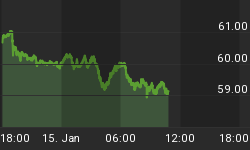Upfront Addendum:
Coast-to-Coast listeners and new readers, please read the story I briefly talked about tonight on my segment with George Noory: My Wife Joanne Has ALS, Lou Gehrig's Disease.
Weekly Unemployment Claims
Initial unemployment claims have generally been trending lower, but in a very choppy manner. One way to smooth out the weekly claims reports is to use seasonal adjustments. Another way is to use 4-week moving averages.
However, both methods are subject to fluctuations around floating holidays such as Thanksgiving and Easter.
Adding a couple of extra weeks to the moving averages and comparing not-seasonally-adjusted numbers to the same six weeks in prior years helps even more. Here are a couple of charts to consider.
Unemployment Claims 6-Week Moving Average vs. Same 6 Weeks in Prior Years

Certainly the number of initial claims has fallen dramatically but claims are still above levels from 2004 through 2008.
Workers With a Job Covered by Unemployment Insurance

The above chart shows 6-week moving averages of employees with a job and with benefits, compared to the same 6 weeks in prior years. Self-employed are not eligible for unemployment benefits.
Reader Tim Wallace who prepared the above charts at my request writes ...
Hello Mish
Anyway, here is the last six weeks filing average compared to prior years. Note that only those years in known recession are greater than the current number of claims in spite of the steep drop.
Also note the six-week moving average of covered employees shows we are at 2001 levels.
However, the economy did legitimately add 1,474,871 jobs in the past year, the first upward trend since 2008. Unfortunately, we cannot determine the quality of said jobs. Moreover, the economy will need to add 17 million more jobs just to get back to employment levels of 2001 on an equal percentage basis to the workforce.
Here are a few more charts and statistics to consider.
Nonfarm Employment

In terms of actual non-farm employment, this "recovery" is now back to a level as seen in 2001. Note that the length of each recovery period has gotten longer and longer.
Here are some additional charts from my April 6 report Nonfarm Payroll +120,000, Unemployment Rate Fell .1 to 8.2%, Record 87,897,000 "Not in Labor Force"
Nonfarm Employment - Payroll Survey - Annual Look - Seasonally Adjusted

Actual employment is about where it was just prior to the 2001 recession.
Quick Notes About the Unemployment Rate
-
US Unemployment Rate dropped .01 to 8.2%
-
In the last year, the civilian population rose by 3,604,000. Yet the labor force only rose by 1,315,000. Those not in the labor force rose by 2,289,000.
-
The Civilian Labor Force fell by 164,000.
-
Those "Not in Labor Force" increased by 310,000. If you are not in the labor force, you are not counted as unemployed.
-
Those "Not in Labor Force" is at a new record high of 87,897,000.
-
By the Household Survey, the number of people employed fell by 31,000.
-
By the Household Survey, over the course of the last year, the number of people employed rose by 2,270,000.
-
Participation Rate fell .1 to 63.8%
-
Were it not for people dropping out of the labor force, the unemployment rate would be well over 11%.
Over the past several years people have dropped out of the labor force at an astounding, almost unbelievable rate, holding the unemployment rate artificially low. Some of this was due to major revisions last month on account of the 2010 census finally factored in. However, most of it is simply economic weakness.
Between January 2008 and February 2010, the U.S. economy lost 8.8 million jobs.
Since a recent employment low in February 2010, nonfarm payrolls have expanded by 3.6 million jobs. Of the 8.8 million jobs lost between January 2008 and February 2010, 41 percent have been recovered.
Statistically, 125,000+- jobs a month is enough to keep the unemployment rate flat. For a discussion, please see Question on Jobs: How Many Does It Take to Keep Up With Demographics?
The average employment gain over the last 25 months has been 143,000, barely enough (statistically speaking) to make a dent in the unemployment rate. Thus, the unemployment rate fell because millions dropped out of the labor force.
















